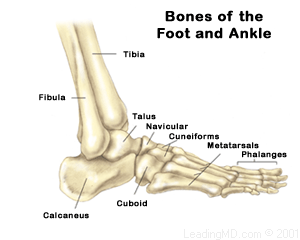







The ankle joint provides the body with balance, stability, and the
ability to bear the body's weight. It must do all these tasks while
being exercised and manipulated over one million times a year.
Ankle sprains are one of the most common orthopedic injuries, occurring equally in both sexes and all ages. These injuries are most often reported by athletes; although it is not uncommon to see ankle sprains in those who suddenly trip on a step, slip without warning or ignore feelings of fatigue during exercise. There are over one million ankle injuries each year and approximately 85% of these injuries are ankle sprains.
Ankle sprains occur in several forms:
the high ankle sprain, the lateral ankle sprain, the medial ankle
sprain, and the low ankle sprain. The high ankle sprain injures
the ligaments connecting the two bones of the lower leg (the tibia
and fibula) at the ankle joint. The medial ankle
sprain injures the inside ligaments, collectively referred to
as the deltoid ligament. The low ankle sprain
involves the ligaments supporting the subtalar joint.
This is the joint just below the true ankle joint. The subtalar
joint is responsible for the foot's ability to turn to the inside
and outside. Almost 85% of ankle sprains occur at the lateral
(outside) aspect of the true ankle joint. This article will
focus primarily on the most common type of ankle sprain: the lateral
ankle sprain. Click here to read more about
ankle structure.
© 2016 by LeadingMD.com All rights reserved.
Disclaimer